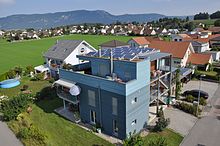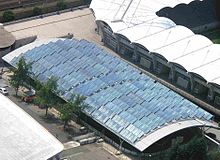Solar system






A solar system is a technical system for converting solar energy into another form of energy. If kinetic energy occurs in the energy conversion chain , i. This means that if the solar system contains moving parts (such as a turbine, a generator or a motor) to convert solar energy into electrical energy , it is also referred to as a solar power plant.
Systematics
Solar systems can be divided into three basic types according to the working principle and the form of energy obtained:
- Thermal solar systems on a smaller scale provide thermal energy in the low temperature range mainly for direct use in households (e.g. solar collectors , solar cookers ).
- Thermal solar power plants also provide heat on a larger, industrial scale and i. d. Usually at much higher temperatures. The heat is mainly converted into electricity (e.g. solar tower power plant ). A direct thermal use z. B. for chemical processes is possible.
- Photovoltaic systems supply electrical energy ( direct current ), which i. d. Usually fedinto the power grid ( alternating current )via an inverter .
Other regenerative energy generation systems are in principle also - albeit indirectly - users of solar radiation energy. The radiation is converted into other forms of energy by absorption , e.g. B. Heat. Thermal power plants are an example here . The sun is the primary driving force in the energetic use of wind, biomass and natural water circulation.
- Photochemical solar systems : photochemical reactions can also be used industrially by means of solar technology.
In particular in the field of wastewater treatment and photosynthesis, various techniques are u. a. was developed by solar research at DLR. Lightly or strongly focussing solar systems are used, which are also used in the field of solar thermal energy.
Thermal solar systems
Thermal solar systems - such as flat solar collectors and evacuated tube collectors - can be used to heat drinking water (shower and bath water) and to generate heat for space heating and, for example, for cooking ( process heat ). A specially coated absorber surface within a so-called thermal "collector" is heated by the electromagnetic solar radiation in the visible and infrared range of the spectrum. A liquid flows through the tubes of the absorber , and more rarely also a gas (e.g. air), which absorbs this heat (heat transport medium). By means of a pump or a fan - sometimes only by the buoyancy of the warming - this medium is fed to a storage tank , cooled there and then fed back to the inlet of the absorber (circuit).
In Central Europe, thermal solar systems - depending on the region - can usually cover 50 to 60 percent of the energy required to heat drinking water. Higher contribution margins or use in building heating technology are also possible. The solar thermal system can support the heating, but the contribution margin depends on various boundary conditions (demand, storage, medium, etc.). The Swiss engineer Josef Jenni showed what is possible with the project for the Oberburger Sonnenhaus as early as 1989: With the appropriate effort, 100 percent coverage of the heat requirements of a single-family home can be achieved with solar energy, and this can also be achieved with an apartment building.
Furthermore, thermal solar systems can be used for process heat generation in industry and commerce. In the food industry in particular, there are many applications for which the necessary temperatures of 60 to 100 ° C can also be generated with collectors. Use in the household ( solar cooker ) is unusual in Europe, but it has been implemented in some projects in Africa and India.
The supply of district heating networks with solar energy is now widespread in Denmark, Sweden and Austria. With special collectors for large-scale systems, the conventional energy supply is supported by solar energy in around 100 localities. In summer, solar heat replaces a biomass boiler in many small networks. But there are also remarkable approaches in the urban area, for example in Graz.
Another area of application is the provision of cold ( solar air conditioning ). Chillers, which are driven with heat from collectors, use solar energy particularly efficiently, because the highest cooling requirement coincides with the strongest solar radiation. There are now over a hundred model systems for research and demonstration, and large commercial projects have also been implemented in recent years. The most prominent installations are in Qingdao / China in the Olympic Sailing Village for 2008, at the Renewable Energy House in Brussels, in Lisbon on the main building of the Caixa Geral de Depósitos as currently the largest solar cooling in the office area worldwide and in Pristina / Kosovo on the building of the European Agency for the reconstruction of Kosovo .
Thermal solar power plants

Thermal solar power plants are not only differentiated from solar systems by their capacity. While a flat absorber usually uses diffuse light in the smaller solar systems, mirrors that focus direct sunlight are usually used in solar power plants. Diffuse light cannot be used here. Accordingly, the technology also has an impact on the choice of location (dry deserts, etc.). There are at least three different concepts for bundling light:
- Parabolic troughs track the sun on one or two axes and concentrate the radiation on an absorber tube in the focal line. This contains a thermal oil which, after being heated, drives a turbine and an electricity generator via a conventional steam cycle. Parabolic trough power plants have been in operation for commercial purposes in the Californian desertsince 1985(total output approx. 354 MW).
- Parabolic mirrors are large, biaxial, sun-tracking, parabolic mirrors with a Stirling engine in the focus, to which an electricity-generating generator is directly attached. Experimentally, in very large systems using a solar Stirling with a connected generator, efficiencies of around 20 percent were achieved.
- Heliostats are mostly large mirrors. They are used to focus the incident sunlight. The heliostats of a solar tower power plant reflect the sunlight onto a central absorber located at the top of a tall tower. The heliostat mirrors are aligned in such a way that they all reflect precisely on the absorber. This means that very high temperatures are reached. The heat obtained in this way is converted into electricity in a downstream “conventional” thermal power plant . One example of this is the Jülich solar tower power plant (STJ) .
Photovoltaic systems
Photovoltaic systems convert the electromagnetic spectrum of our sun "directly" into electrical current in sometimes extremely thin semiconducting layers. The core element are the solar cells (grouped into modules), which separate positive and negative charges by bombarding the radiation with photons . If an electrically conductive connection is now established between the charge zones, a current will flow. The power gained in this way can either be used directly, stored in solar batteries or fed into or into the public grid with the help of inverters . Systems with a peak output of several megawatts are now being built and operated.
Solar system and monument protection
Solar systems and monument protection are in a tense relationship, since solar systems on the roof usually interfere with the substance of the building and / or its visual effect. Since resource conservation and sustainability are part of the legal mandate of monument protection and monument preservation, there have been efforts of monument preservation for many years (as of 2010) to find sensible solutions. In order to erect solar systems on a listed building, it is often necessary to deal intensively with project and solution proposals for the integration of solar modules. In case of doubt, a judicial clarification may be necessary. In the last few years (as of 2012) the tendency of the jurisprudence - depending on the concrete aspects - is no longer unreservedly friendly to monument protection.
See also
- List of power plants (including solar power plants)
- Solar simulation
- Solar filling station
- Monitoring systems for solar systems
Web links
- Information on renewable energy at
- Subject energy , an offer from the German Energy Agency
- BINE Information Service - Energy research for the practice of FIZ Karlsruhe and PtJ on behalf of the BMWi
- Cities with a solar cadastre in the portal for energy-efficient building and renovation
- Jülich solar tower power plant
- Solar thermal power plants ( Memento from June 11, 2007 in the Internet Archive ) (Powerpoint file, overview)
Individual evidence
- ↑ Stiftung Warentest - test of solar systems , test 03/2009
- ↑ picture ( Memento from November 5, 2004 in the Internet Archive )
- ↑ Heating with the sun ( Memento from January 6, 2009 in the Internet Archive )
- ↑ Examples of solar air conditioning
- ↑ Results in the South of France ( Memento from May 17, 2007 in the Internet Archive )
- ↑ Tomke Lisa Menger: Article: Old substance meets new energy - Do solar systems affect monuments? In: www.energieagentur.nrw. EnergieAgentur.NRW, October 1, 2018, accessed on July 4, 2020 .
- ↑ Ulrike Roggenbuck, Ruth Klawun, Roswitha Kaiser: Worksheet 37: Solar systems and monument protection. Information from the Association of State Monument Preservators, prepared in spring 2010 by the construction technology working group. In: www.dnk.de. Association of State Monument Preservators in the Federal Republic of Germany, 2010, accessed on July 4, 2020 .
- ↑ Annette Stoppelkamp: Monument protection can be in harmony with renewable energies. Don't let that stop you from using the roof or the facade with solar energy! In: www.sfv.de. Solarenergie-Förderverein Deutschland eV (SFV) , June 24, 2020, accessed on July 4, 2020 .
- ^ Stefan Pützenbacher: Renewable energies vs. Monument protection. Does monument protection law conflict with environmental protection? In: publicus.boorberg.de. Publics (Richard Boorberg Verlag), February 15, 2012, accessed on July 4, 2020 (German).